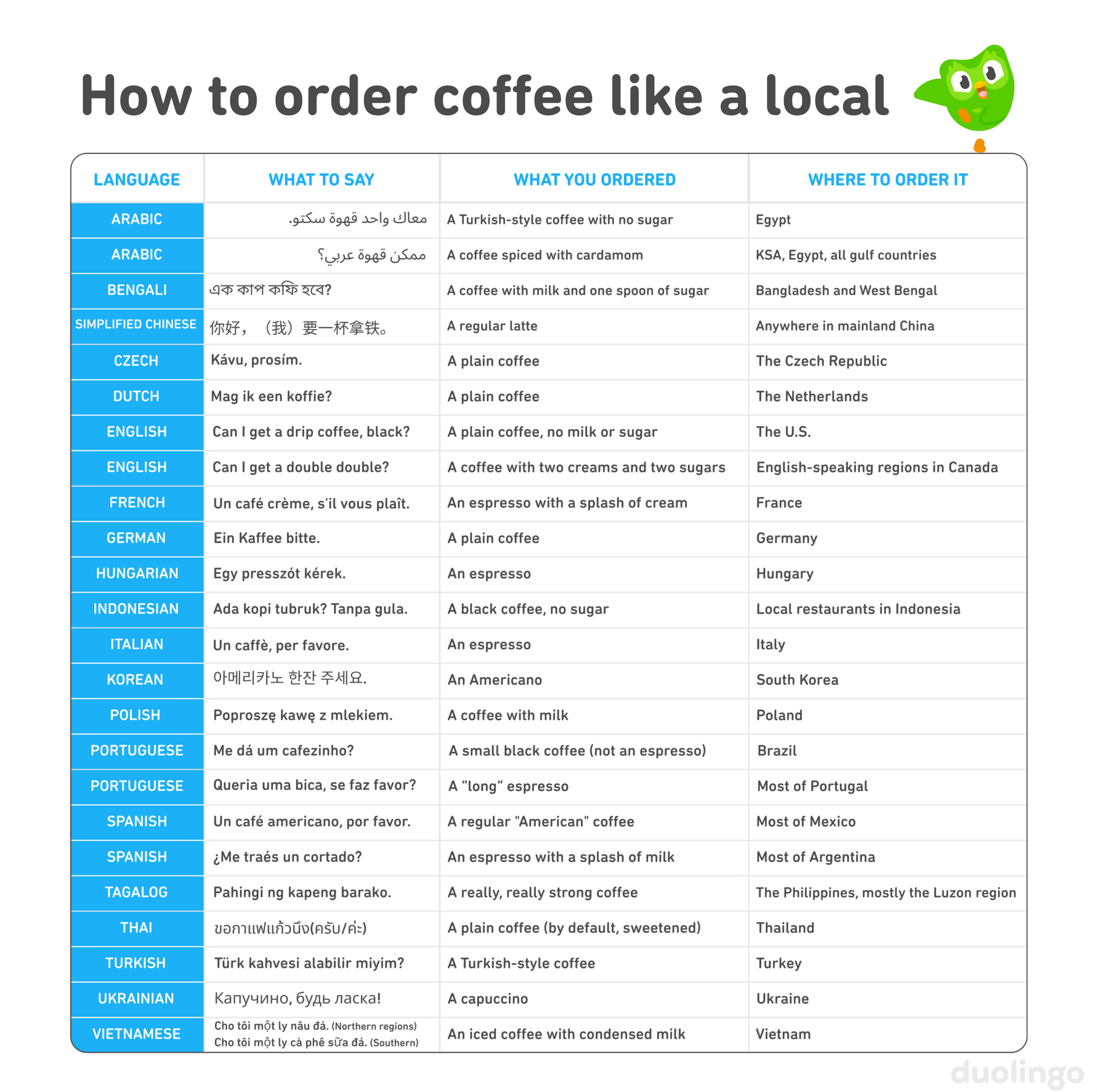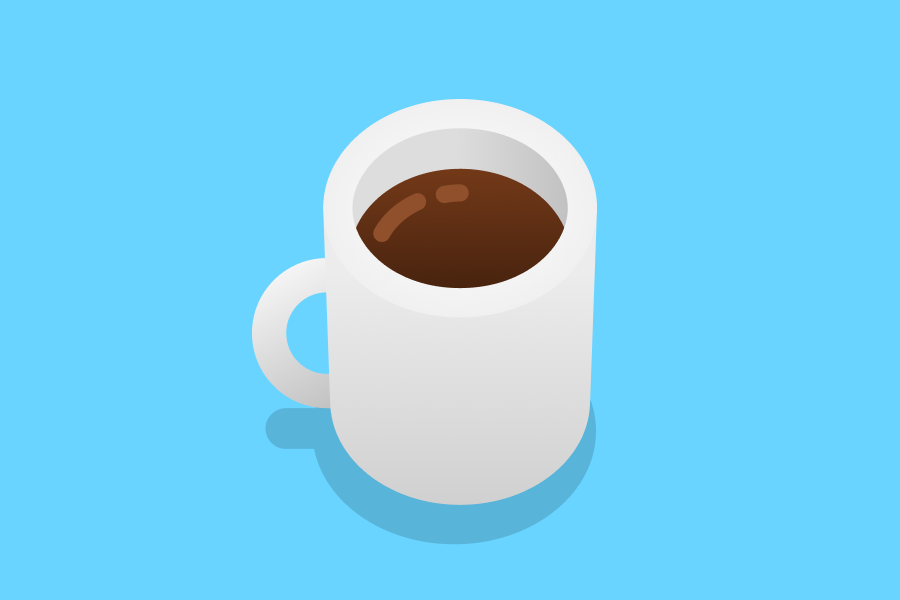Have you learned the word for "coffee" in your new language yet? It's taught pretty early in a lot of our courses, and there are many reasons that we do this, one being: It’s an essential word for many travelers! Actually, it’s just an… essential word.
“Coffee” is the same (or similar-looking) in many languages, but the customs around drinking it are different across the world. In honor of International Coffee Day (a very real holiday), we’re looking at the different ways people enjoy their morning beverage all over the globe!
Switch up your coffee order
In France, the typical breakfast order is a café au lait (coffee with hot milk) and it’s common for the whole family to indulge–even kids!—and drink it out of a small bowl. And if you order un café in Paris, they’ll hand you an espresso! (In Spain, an espresso is a popular after-dinner drink.)
In Italy, you don’t even need to use the word espresso—this is known as un caffè or un caffè normale. And if you want a latte, don't order un latte... unless you want a plain glass of milk! Another important word to know when in Italy: The word bar is another word for café!
In Amsterdam, there’s another false cognate for English-speakers to be aware of: A koffiehuis or café will get you a cup of coffee, but a coffeeshop actually sells marijuana!
Do you take milk with your coffee? A classic Vietnamese coffee is known as cà phê sữa đá in which coffee is strained with a phin over ice and sweetened condensed milk. Sữa đá literally translates to “iced with milk,” and is typically used in Southern countries—if you’re in northern Vietnam, you’ll call it a nâu đá (literally, “iced brown”) but it’s the same order! Cambodian coffee can be ordered black or with milk, and they also use sweetened condensed milk. But in Colombia, the default is black coffee. In English-speaking parts of Canada, people who want two creams and two sugars in their coffee should order a “double double.”
One of the best coffee drinks in Mexico is known as café de olla—it’s a sweeter drink, and delicious! And in the Netherlands, if you want coffee that’s heavy on the milk, order a koffie verkeerd or “wrong coffee.” In China, coffee brands have come up with innovative ways to serve coffee, and many popular coffee drinks include fruit, like a durian or watermelon latte!
Coffee culture around the world
Getting your coffee to-go is much more common in the U.S., but most other countries consider a cup of coffee to be a leisurely, social activity. In fact, the “coffee break” is an important ritual, and shouldn’t be rushed! In Germany, Kaffeezeit (coffee time) is typically between 3 and 4 p.m. and accompanied by a bite of cake! Sweden has a similar tradition around fika, a daily ritual that involves a midday coffee break and a fikabröd (sweet pastry) to accompany the drink.
Though cafés are now a spot to catch up with a friend or take a break with a coworker, hundreds of years ago, they were intellectual hubs for people looking to discuss philosophy, politics, and more! In fact, in Paris, café culture became one of the primary reasons that the French Revolution was able to get off the ground, because intellectuals were spending a lot of time sitting around in cafés discussing how things could and should be different.
In China, coffee was introduced at the end of the Qing Dynasty, about 100 years ago. The first coffee house "Hongkou Coffee House" appeared in Shanghai in 1886! In Russia, Peter the Great tried to get his court drinking coffee, but people were unenthusiastic and turned off by the drink’s bitter taste. It took a while for coffee to catch on, but during the 18th century, Turkish-style coffee became the popular beverage.
This style of coffee remains popular in Turkey, and is prepared using finely-ground, unfiltered coffee beans. The leftover grounds are sometimes used to tell fortunes. In Turkey, coffee is often served with something small and sweet to eat, like a Turkish delight. People also drink Turkish-style coffee in Egypt, where ordering a “plain coffee” often still includes a bit of sugar. But if you want the original, bitter version, order a plain coffee using the word سكتو (sketto), which literally means “to shut up,” in reference to the bitterness of the coffee!
There are many Turkish traditions around coffee worth noting, too! Before a Turkish wedding, it is tradition for the prospective bride to make a cup of Turkish coffee with salt instead of sugar and offer it to the groom. The groom is expected to drink the salty coffee (without making a face) as a symbol of his love for the bride and willingness to endure the difficulties of marriage.
Japan has become one of the biggest coffee consumers in the world, and though there are plenty of “normal” coffeeshops, there are other unique options you can visit, from a manga cafe (read comics while you drink!), to animal cafes, where you can feed or pet dogs, cats, owls, and other animals, to a pop-culture cafe tied to a beloved franchise, like Pokémon or Totoro!
Can I get a...
Okay, but what do you do when you’re on vacation abroad and want to order coffee (or espresso, or tea) but aren’t sure what to ask for? We asked our language experts to share some of the most common caffeine orders in different languages and locales, so you can fit right in on your next vacation (and get your day off on the right foot!)

How do you take your coffee?
Coffee is a personal choice, but the morning ritual is universal. How do you take your coffee, and what fun caffeinated beverages have you tried around the world? Tweet us at @Duolingo and let us know! Cheers! ☕️
Thanks to our fantastic team of language experts and translators for their help!
